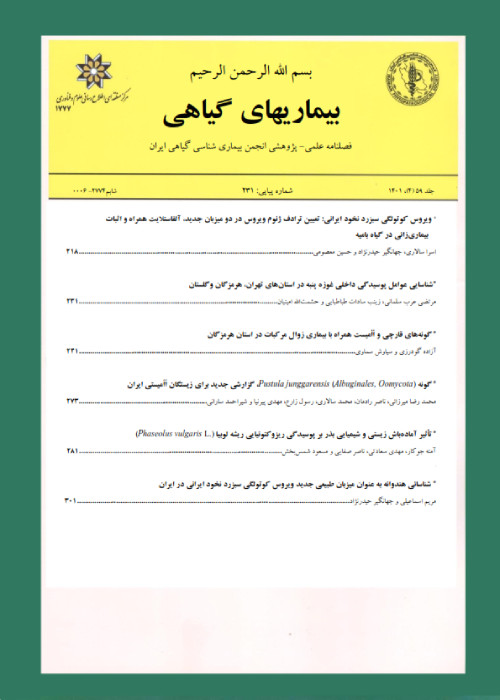Occurrence and pathogenicity of some fungal species on broomrape
Broomrape species (Orobanche spp.), obligate parasitic plants, are considered as the limiting factors for cultivation of several important agricultural crops which cause damage and crop lost in dicotyledons such as tobacco, tomato, eggplant, potato, sunflower and carrot (Barker et al., 1996; Sauerborn, 1991). Although several traditional methods have been used to control broomrapes on different crops, none has proved to be effective (Amsellem et al., 2001). On the other hand effective methods such as soil fumigation are expensive and also have environmental risks (Foy et al., 1989). Biological control is an alternative control method and a number of promising fungal isolates have been reported all over the world with satisfying level of control on these pathogens (Boari and Vurro, 2003). Fusarium oxysporum, F. solani, Rhizoctonia solani and Urocystis orobanches have been reported from broomrape in Iran (Ershad, 2009). Rostami and co-workers (2015) isolated F. proliferatum, F. torulosum and F. circinatum. Also F. chlamydosporum, F.solani, F. semitectum, F. oxysporum, F. reticulatum, F. pallindoroseum, F. diversisporum and F. virguliform were reported fromEgyptian broomrape, O. aegyptiaca (Darvishnia et al., 2013).In order to study fungi associated with broomrape, samples of O.ramosa with wilt and/or rot symptoms in their stem and crown were collected from tomato fields in Firoozabad and gharegheshlagh villages in Kosar city, Ardabil province. Pieces of stems were first washed with running tap water, sterilized in 1% sodium hypochlorite for 2 min, and rinsed with sterile distilled water. The fragments were placed on potato dextrose agar and incubated at 25 °C and observed daily for fungal growth. The fungal isolates were purified and stored. Finally a number of 90 isolates were obtained of which 46 isolates were identified based on their morphological and microscopic characteristics on PDA and CLA (for Fusarium species) (Leslie and Summerell, 2006). Also genomic DNA of a representative isolate for each morphologically identified species was extracted (Liu et al., 2000) and their internal transcribed spacers of ribosomal gene (ITS1 + 5.8S + ITS2) was amplified using the primers ITS1 and ITS4 (White et al. 1990). PCR products were sent to Macrogen Inc. (South Korea) for purifying and sequencing. The sequence of amplicons was compared with sequences from NCBI using BLAST. Isolates belonging to the species of dominant genera were inoculated on broomrape tubercles in transparent plastic bags containing tomato seedlings. After three weeks the symptoms were assessed based on a visual score as follow: 0: nonpathogenic; 1:slight symptoms on tubercles, such as browning and slackening of growth rate; 2: inhibition of growth and tubercle browning and necrosis; 3: quick and complete necrosis of tubercles, loss of consistency. Three replicates were used for each species. Based on the morphological and molecular characteristics of 46 isolates, the isolates belonged to three genera Fusarium (frequency: 3/41%), Macrophomina (frequency: 4/54%) and Aspergillus (frequency: 3.4%). This is the first report of the occurrence of Aspergillusochraceus and F. fujikuroi on broomrape in the world. Also before this research there is no report on the occurrence of Macrophomina phaseolina, F.acuminatumand F.equiseti on broomrape in Iran. Based on the results of pathogenicity experiment, all tested Fusariumspecies and M. phaseolina caused disease symptoms on broomrape tubercles. Among the species, F. acuminatum, F. fujikuroi and F.proliferatum caused the most disease severity on tubercles.
Biocontrol , Broomrape , Fusarium , Tomato
- حق عضویت دریافتی صرف حمایت از نشریات عضو و نگهداری، تکمیل و توسعه مگیران میشود.
- پرداخت حق اشتراک و دانلود مقالات اجازه بازنشر آن در سایر رسانههای چاپی و دیجیتال را به کاربر نمیدهد.


